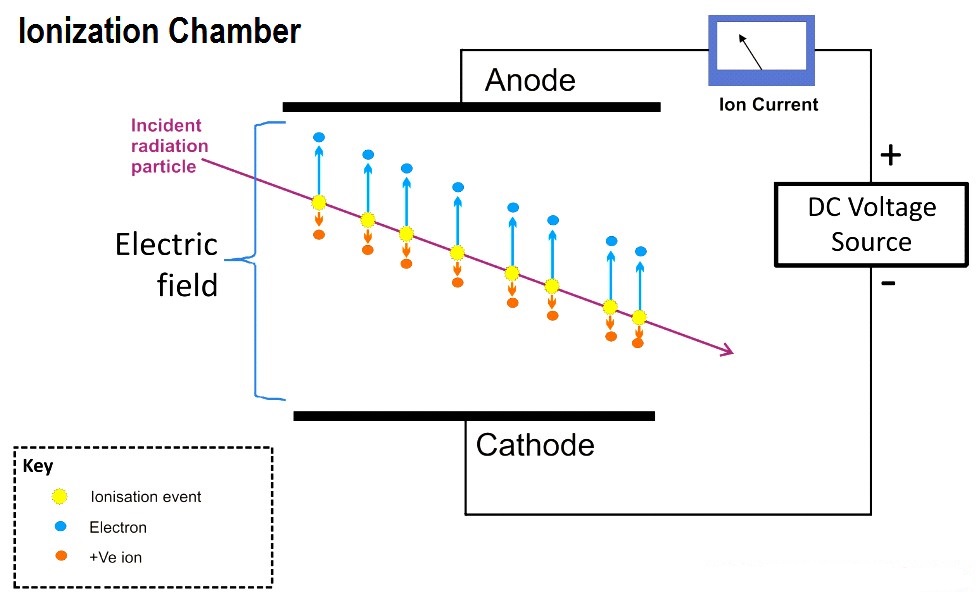The ionization chamber is the simplest of all gas-filled radiation detectors, and is widely used for the detection and measurement of certain types of ionizing radiation; X-rays, gamma rays and beta particles. Conventionally, the term “ionization chamber” is used exclusively to describe those detectors which collect all the charges created by direct ionization within the gas through the application of an electric field. It only uses the discrete charges created by each interaction between the incident radiation and the gas, and does not involve the gas multiplication mechanisms used by other radiation instruments, such as the Geiger-Müller counter or the proportional counter.
Ion chambers have a good uniform response to radiation over a wide range of energies and are the preferred means of measuring high levels of gamma radiation. They are widely used in the nuclear power industry, research labs, radiography, radiobiology, and environmental monitoring.
Principle of operation
An ionization chamber measures the charge from the number of ion pairs created within a gas caused by incident radiation. It consists of a gas-filled chamber with two electrodes; known as anode and cathode. The electrodes may be in the form of parallel plates (Parallel Plate Ionization Chambers: PPIC), or a cylinder arrangement with a coaxially located internal anode wire.

Figure : Schematic diagram of parallel plate ion chamber, showing drift of ions. Electrons typically drift 1000 times faster than positive ions due to their much smaller mass.
A voltage potential is applied between the electrodes to create an electric field in the fill gas. When gas between the electrodes is ionized by incident ionizing radiation, ion-pairs are created and the resultant positive ions and dissociated electrons move to the electrodes of the opposite polarity under the influence of the electric field. This generates an ionization current which is measured by an electrometer circuit. The electrometer must be capable of measuring the very small output current which is in the region of femtoamperes to picoamperes, depending on the chamber design, radiation dose and applied voltage.
Each ion pair created deposits or removes a small electric charge to or from an electrode, such that the accumulated charge is proportional to the number of ion pairs created, and hence the radiation dose. This continual generation of charge produces an ionization current, which is a measure of the total ionizing dose entering the chamber. However, the chamber cannot discriminate between radiation types (beta or gamma) and cannot produce an energy spectrum of radiation.
The electric field also enables the device to work continuously by mopping up electrons, which prevents the fill gas from becoming saturated, where no more ions could be collected, and by preventing the recombination of ion pairs, which would diminish the ion current. This mode of operation is referred to as “current” mode, meaning that the output signal is a continuous current, and not a pulse output as in the cases of the Geiger-Müller tube or the proportional counter.
Referring to the accompanying ion pair collection graph, it can be seen that in the “ion chamber” operating region the collection of ion pairs is effectively constant over a range of applied voltage, as due to its relatively low electric field strength the ion chamber does not have any “multiplication effect”. This is in distinction to the Geiger-Müller tube or the proportional counter whereby secondary electrons, and ultimately multiple avalanches, greatly amplify the original ion-current charge.

Figure : Plot of ion current against voltage for a wire cylinder gaseous radiation detector. The ion chamber uses the lowest usable detection region.


